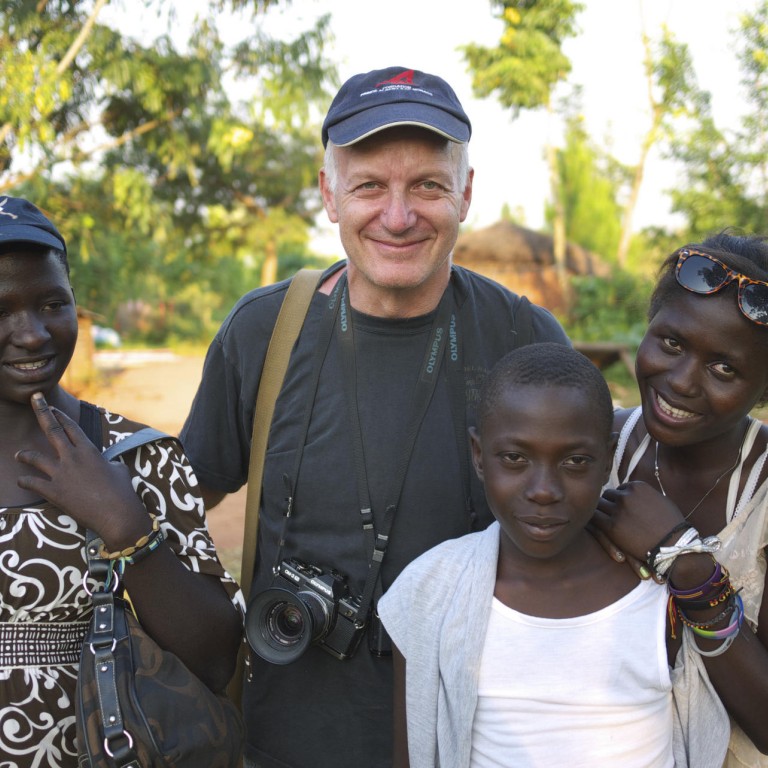
Profile: Life is beautiful for photojournalist Nick Danziger
Recently back from North Korea, the documentary photographer says he finds beauty in ordinary people doing ordinary things
It's no surprise to learn that, as a child, British photojournalist Nick Danziger idolised Tintin, the intrepid young reporter who is the central character of the comics series created by Belgian cartoonist Hergé.
"I've always travelled. I left home for the first time when I was 12 years old, inspired by Tintin … adventure was always there," says Danziger by phone from Monaco, his current base. This month his work brings him to Hong Kong for the launch of "Above the Line: People and Places in the DPRK", which will run at the Hong Kong Arts Centre in Wan Chai from April 9-28.
The photographs on display are from more than 7,000 taken in North Korea in 2013 when Danziger travelled there under the auspices of the British Council, visiting the cities of Pyongyang, Nampo, Wonsan and Sariwon. The exhibition shows people doing ordinary things - women swimming in the ocean, a man waiting for a tram, students walking down a street - as well as less-ordinary sights such as a much-decorated hero of the Korean war on his way to the Victorious Fatherland Liberation War Museum in his Mercedes, dancers practising in a car park before a performance at the Arirang Mass Games, and a glimpse into the routines of workers on a collective farm.

It's a fascinating and rare glimpse into the communist country of almost 25 million people that has the dubious honour of being the world's most militarised society. It is also a great example of what Danziger does best: providing a peephole into a country, in particular isolated countries, showing the real side of its people and often shattering preconceived perceptions.
"Each day in North Korea was taken up with meeting people and encouraging them to talk about their lives, so that a picture emerges of individuals whose smallest pleasures are not all that different from people elsewhere, however strange or limiting their circumstances may appear to us," he says. "I wasn't interested in showing people carrying guns, but was more interested in how they lived."
And how they lived surprised Danziger, as he captured various subjects getting on with their daily lives. "I was surprised to see people swimming at the beach. It's a rarity. You can even rent your bathing costume. People you see in the images were so incredibly friendly … They were offering me kebabs and alcohol."

Born in London but raised in Monaco and Switzerland, Danziger's creative journey didn't start with photography. He was a painter and sculptor, showing at the Robert Fraser gallery in London (in the Swinging Sixties, the gallery was the place to be on exhibit for any artist from Europe or America). He is also known as an author and filmmaker, but if you ask him what he does today, he'll tell you he's a photographer.
Danziger was awarded a Winston Churchill trust fellowship in 1982 that was to fund a trip through Central America. "The plan for the grant money was that it would allow me to build my own dugout canoe and take it through the jungles of Central America."
Sadly, the assignment fell through. What didn't fall through, however, was his need to feed his travel fix, so he planned an 18-month journey along the ancient Silk Road. "I clandestinely trekked through many dangerous zones … I crossed Iran and Iraq during the wars there into Afghanistan, into China." He also walked through Turkey and became the first foreigner to cross into China via the Khunjerab Pass in Pakistan since the 1949 revolution.
"From a young age, I have always gone to difficult places," he says.
When he returned home, he was expecting to go back to painting but "instead I found it really difficult to adjust", he says.
Danziger went back on the road and has not looked back.
I did an assignment on the Walled City [in Kowloon] before it was destroyed [in 1993], and I've also worked with people who have abused substances, so I've seen many sides of the city.
"I was one of the lucky ones," he says. "I could get out of these hot spots. But even Afghanistan in the mid-'80s, when it was occupied by the Soviet Union, there were times when we were getting bombing raids, shellings, ground attacks on a daily basis. That was the level of destruction there … I've been going to Afghanistan for more than 30 years and have been there during the different wars. It's depressing: just when you think it can't get any worse, it does."
He has also visited Hong Kong many times and has witnessed its rapidly changing landscape. "I did an assignment on the Walled City [in Kowloon] before it was destroyed [in 1993], and I've also worked with people who have abused substances, so I've seen many sides of the city. I love Hong Kong, and I visit nearly every year … The amount of diversity in such a small area is extraordinary."
Another project he is working on is a long-term assignment close to his heart. "It's a 10-year, eight-country project where I'm revisiting some of the stories," he says.
"It's one of the best projects I've been involved with … I built up an intimate relationship with some of my subjects, having visited some at least three times over a decade, so yes, it's very close to my heart."
"Above the Line: People and Places in the DPRK", The Experimental Gallery, 3/F, Hong Kong Arts Centre, 2 Harbour Road, Wan Chai, April 9-28

